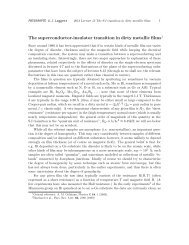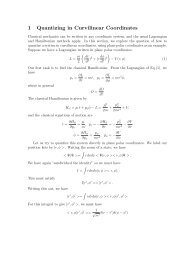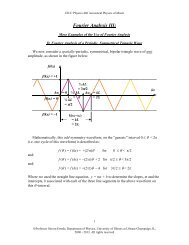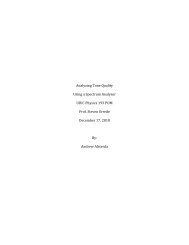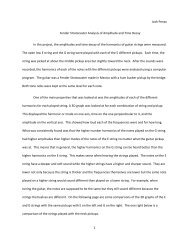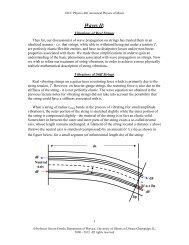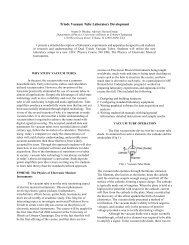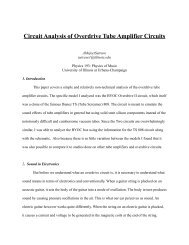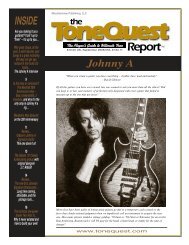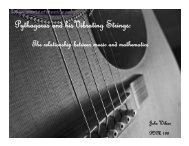Harmonics of a Guitar Physics 199POM Prof. Steven Errede ...
Harmonics of a Guitar Physics 199POM Prof. Steven Errede ...
Harmonics of a Guitar Physics 199POM Prof. Steven Errede ...
You also want an ePaper? Increase the reach of your titles
YUMPU automatically turns print PDFs into web optimized ePapers that Google loves.
<strong>Harmonics</strong> <strong>of</strong> a <strong>Guitar</strong><br />
<strong>Physics</strong> <strong>199POM</strong><br />
Pr<strong>of</strong>. <strong>Steven</strong> <strong>Errede</strong><br />
December 8, 2008<br />
By:<br />
Megan Abraham and Danielle Rodriguez<br />
1
The guitar is one <strong>of</strong> the most popular instruments in music today. It is used for all types<br />
<strong>of</strong> music including rock, country, jazz, and many more. The guitar was first created in the 1500’s<br />
in Spain. The first guitars were very small and only had four strings. The first guitars were closer<br />
in relation to today’s ukulele. <strong>Guitar</strong>s <strong>of</strong> our more recent era are made up <strong>of</strong> several different<br />
parts that help produce the sound that we hear in today’s music industry. The guitar is made up<br />
<strong>of</strong> a hollow body, a head (which contains the tuning pegs), the neck (which holds the frets) and<br />
the soundboard, which allows us to be able to hear the guitar’s sound. <strong>Guitar</strong>s most <strong>of</strong>ten have 6<br />
strings that are attached to the bridge <strong>of</strong> the guitar and the tuners. Each <strong>of</strong> these parts helps make<br />
the guitar’s unique sound.<br />
All these parts play a key role in the production <strong>of</strong> sound. When the strings are plucked<br />
on the guitar, they vibrate. These vibrations travel through the saddle (the piece <strong>of</strong> the bridge that<br />
they are embedded in) and then to the bridge. Since the bridge is attached to the soundboard, the<br />
entire soundboard starts vibrating. Because the body <strong>of</strong> the guitar is hollow, the sound that is<br />
produced from these vibrations is then amplified to make the sound that we hear.<br />
Each guitar is different in the sound that it produces. Based on the shape, type <strong>of</strong> material<br />
it is made out <strong>of</strong>, size, and other elements, you can produce many different types <strong>of</strong> sounds on<br />
different guitars. Another way to change the sound <strong>of</strong> a single guitar is to adjust the tuning pegs.<br />
By adjusting the tuning pegs, you are increasing or decreasing the tension that is placed on the<br />
string. You can also place your fingers on different parts <strong>of</strong> the strings on the finger board, to<br />
change the notes that are being played.<br />
In our case study, we used different means <strong>of</strong> plucking to change the sound that we<br />
produced. We also changed the place <strong>of</strong> where we plucked the strings. We used both our thumb<br />
over the sound hole, a pick over the sound hole and a pick over the bridge to vary our results. By<br />
2
changing the means <strong>of</strong> what we were plucking the guitar strings with, we also changed the<br />
harmonics that were produced by the guitar. By changing the location or the way that we plucked<br />
the strings, the vibrations that the strings produced gave <strong>of</strong>f dissimilar sound waves at a given<br />
frequency, which is determined by the density <strong>of</strong> the strings and the tension with which they are<br />
stressed.<br />
In this experiment we specifically observed the different harmonics <strong>of</strong> the A string <strong>of</strong> a<br />
classical guitar. The results were somewhat expected. Using the thumb at the sound hole<br />
produced a much louder sound than the other results. Picking at the guitar produced a clear, yet<br />
quiet sound. Picking at the bridge <strong>of</strong> the guitar was a little different than the other results. We<br />
saw that the picking at the bridge was very high in the 4 th harmonic as opposed to the<br />
fundamental. This was interesting to see and provided a good variety in our results.<br />
We used a Yamaha CG-150SA classical guitar with nylon strings for our experiment.<br />
When we began the experiment we varied picking, using the thumb and picking the string at the<br />
bridge for all six strings <strong>of</strong> the guitar. It would be very tedious to analyze all six strings so we<br />
chose to use the A string because it was very rich in harmonics. We discovered this when we<br />
measured the mechanical resonances <strong>of</strong> this guitar. To find the mechanical resonances we used a<br />
piezo-electric transducer to put mechanical energy into the guitar to mimic the sound <strong>of</strong> that the<br />
guitar really makes, and record the mechanical vibrations it emits.<br />
3
The first resonance peak in frequency is at about 105 Hz which closely resembles the<br />
note A2 (110Hz). The second peak is at a frequency <strong>of</strong> ~ 235 Hz which is about an A #3 . From this<br />
we concluded that the A string was the most rich in harmonics so we chose to observe the<br />
different harmonics produced by the A string.<br />
The results showed that overall the A string had a louder sound when the thumb was used<br />
to pluck the string, it was quieter when the string was picked and that the sound was different<br />
and quiet when it was picked at the bridge. Specifically our observations <strong>of</strong> the harmonics <strong>of</strong> the<br />
A string showed us that by picking at the string, there was a quiet, yet clear sound.<br />
4
The harmonics associated with picking the string at the sound hole (i.e. close to the neck) are<br />
clearer, with the fundamental as the most prevalent harmonic. Using the thumb and picking the<br />
string at the bridge produced much different results, as shown in the figures below:<br />
5
As can be seen by comparing the above two graphs with the graph below, picking the strings <strong>of</strong><br />
the guitar at the sound hole/near the neck (using either a pick or thumb), the sound is a lot louder<br />
than picking at the bridge. Picking the string at the bridge produced the most interesting results.<br />
As seen in the following graph, the 4 th harmonic is much more prevalent/stronger than the<br />
fundamental, which is the reason for the much different (brighter) sound when picking at the<br />
bridge <strong>of</strong> the guitar. It is also a quiet sound because we used a pick rather than the thumb.<br />
6
Overall, this experiment tested and proved that different sounds and harmonics are<br />
produced by varying the method <strong>of</strong> producing the sound. Plucking and picking at the sound-hole<br />
produced much different results than picking at the bridge. It was interesting to see that the 4 th<br />
harmonic was the major contributor when a string was picked at the bridge, which makes sense<br />
due to the unique, bright sound that it produces. Also, the whole process <strong>of</strong> determining the<br />
mechanical waves <strong>of</strong> a guitar was interesting to observe and understand. In the future it would be<br />
beneficial to test different effects <strong>of</strong> at least one more string to have a comparison to the<br />
harmonic-rich A string. However, using the A string produced the most useful data for this<br />
experiment.<br />
7



